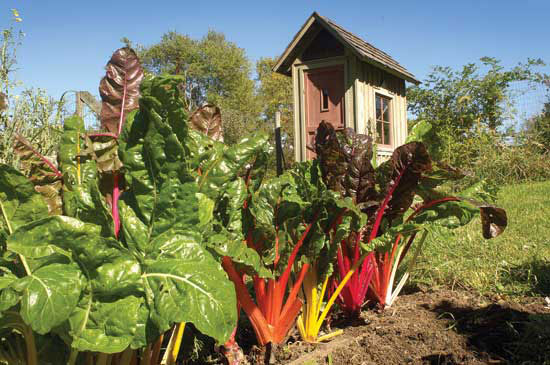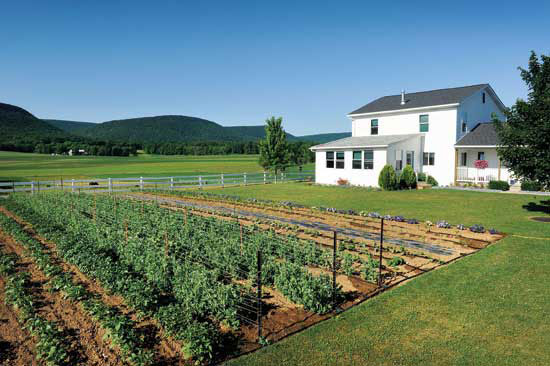Former county extension agent Clifton Slade has been raising commercial vegetables for years. But it wasn’t until he attended a Sustainable Agriculture Working Group workshop a couple of years ago that he started learning how to do more with less—less land, that is. At the workshop, Slade spoke with farmers who were grossing $1 per square foot in greenhouses. “I thought if it could be done inside, why not outside?”
So Slade went back home to Surry County, Virginia, and started intensively farming a quarter acre with the goal of raising a pound, a bunch, or a head of produce in every square foot. “It worked so well that first year, I thought, ‘Oh, I can make a fortune.’”
Slade began calling area CSAs (community supported agriculture) to see what types of produce their customers wanted that the CSA was not providing. Soon he was harvesting carrots, beets, turnips, romaine and other lettuces, kale, onions and cabbage, filling niche markets no other local vegetable producers were filling. His first year he established 20 beds in a quarter acre.
The secret is in the soil
The secret to such prolific plants is in the soil, of course. Farmers and gardeners have to be active with liming, drip irrigation, and planting of winter cover crops, all of which Slade does. He admits it is labor intensive farming. But it’s not that hard to get started. “All you need is a 100-foot length of twine and two tomato stakes,” he says. He plants rows a foot apart. One can do it by hand, hoeing along the twine tied between two stakes, or fashion a tiller with pieces of rebar attached to the back to dig the rows with less labor.
Slade was so excited by how proper soil management increased his harvest and enabled him to produce more in less space that he took the “$1 per square foot” idea to his boss at Virginia State University and Virginia Cooperative Extension, where he works part-time for the school’s Small Farm Outreach Program as a vegetable/produce specialist.
“Clif came to me and said, ‘I can make $43,560 off one acre of land,’” says William Crutchfield, director of the Small Farm Outreach Program. Slade asked for 2 acres of university land to prove it. Crutchfield thought the idea was a good one for the small and often socially disadvantaged and economically limited farmers the program serves. When they started the initiative, Crutchfield says, “We were building the airplane as we were flying it.”
Taking off
That was two years ago. Today the 43,560 Initiative—as it has come to be known, because there are 43,560 square feet in an acre—is the Small Farm Outreach Program’s most popular initiative. And it’s easy to understand why: When university cooperative extension staff start talking specifics to farmers, they listen, especially when, as Crutchfield points out, “you’re talking dollars.” Slade, who had already been implementing this method on his own farm for two years, headed up the $43,560 Initiative. “A lot of people thought we were crazy,” he says, “but we proved that you could do it.”
“No. 1 is the fertilization,” Slade says, noting that even though the 2-acre pilot project at VSU is not certified organic, it uses entirely organic farming practices. They keep it simple using what Slade refers to as “5-gallon bucket technology.” For every 500 square feet of garden, Slade employs one 5-gallon bucket of pelletized poultry manure and 10 5-gallon buckets of mushroom compost.
Currently, the shiitake mushroom compost comes from Pennsylvania, and it costs between $800 and $1,200 to ship a truckload. Overall production costs for 1 acre of produce farming on this condensed and intensive scale is about $10,000. Compost costs could be lowered substantially, though, by using livestock manure, fruit and vegetable scraps, and other organic matter to fertilize.
It’s not cheap to start, which is one reason why Slade recommends starting small, ideally with no more than a quarter acre at first. Some 2,000 farmers in the area are learning how to implement the 2-year-old 43,560 Initiative, and Slade says at least two are making serious money at it. “A lot of farmers aren’t doing it totally but are adopting some of the practices,” he says.
Start small, grow slow
Slade advises any farmer wanting to try this form of production to start small and look at raising ingredients that would go in a tossed salad if they want to market to CSAs and farmers’ markets. “Become a dependable CSA producer,” he says, noting that there is potential to raise well over $1 per square foot. “Tomatoes bring more than $1 per square foot, for example, but they have to be harvested three times a week.”
“This is intensive management,” Slade says. “It’s not for the hobby farmer.” Think square-foot gardening on a commercial scale. Slade says to expect each bed to consume about 10 hours of labor, including prepping, seeding, planting, weeding and harvesting. At Virginia’s minimum wage, that’s almost $75 per bed for a farmer hiring labor.
But results are impressive. VSU has, for example, raised 550 bushels of sweet potatoes in an acre. “Irrigation is a must,” Slade says. “We make sure farmers have sufficient water flow, though if you have a faucet in your barnyard, then you have enough.” Installing a simple drip irrigation system costs about $500, but the investment can pay off in the long run.
Even with the high start-up costs—expect to spend a quarter of gross profits to pay for production—the 43,560 Initiative may sound too good to be true. And in some ways, it is. There is nothing easy about it. “The learning curve is about three to five years,” Slade says. “Start with a quarter acre. You can’t do this on 10 acres.”
One has to have a market as well. “Grow a niche crop,” he says. “Don’t try to compete with mainstream vegetable growers. Think outside the box.” If that means raising bok choy, then learn how to grow bok choy.
“Look very closely at the demographics of your market,” Crutchfield says. “We work very closely with the Hispanic market here in Virginia.” Small-scale farmers may find they can cater to the unique needs of a local immigrant market.
Currently, Slade sells his produce to two CSAs with a total of about 600 customers, though he says a farmer could double his or her money by selling directly to customers at a farmers’ market. Last season he saw sweet potatoes go for $11 a pound. It’s very possible to gross $40,000 in an acre of sweet potatoes in a single year.
More on the horizon
VSU intends to experiment with winter cover crops in order to create its own fertilizer for the soil so the staff can teach area farmers to do the same. They’ve planted buckwheat, sunflowers, sorghum grass and peas so far.
Crutchfield says the 2-acre test plot at VSU has drawn a lot of interest over the past couple of years. “It has turned into a learning lab,” he says. “A lot of people coming back to farm or who want to start farming are volunteering here to educate themselves.”
This intensive gardening method can reap the rewards if it’s your dream to own and operate your own small-scale farm. With determination, significant elbow grease and a lot of compost, $1 or more per square foot is a very real possibility.
Need more convincing? This cost-breakdown analysis proves growing a vegetable garden saves you money.
For more information
Virginia State University Cooperative Extension
Small Farm Outreach Program
804-524-5493
Deborah Huso is a freelance writer living on a small farm in Barboursville, Virginia. She is a contributing editor for The Progressive Farmer. Visit her website.









